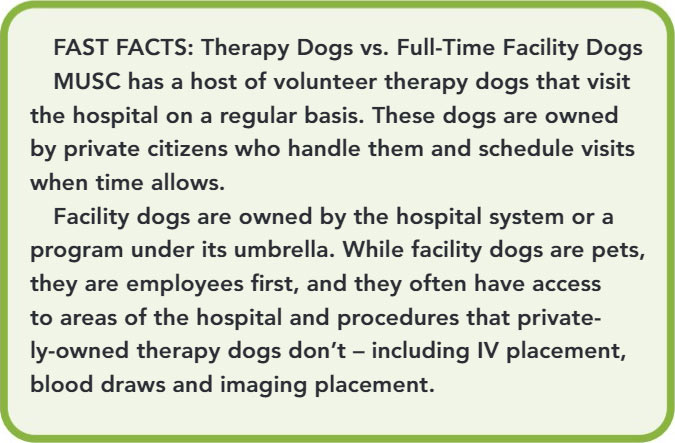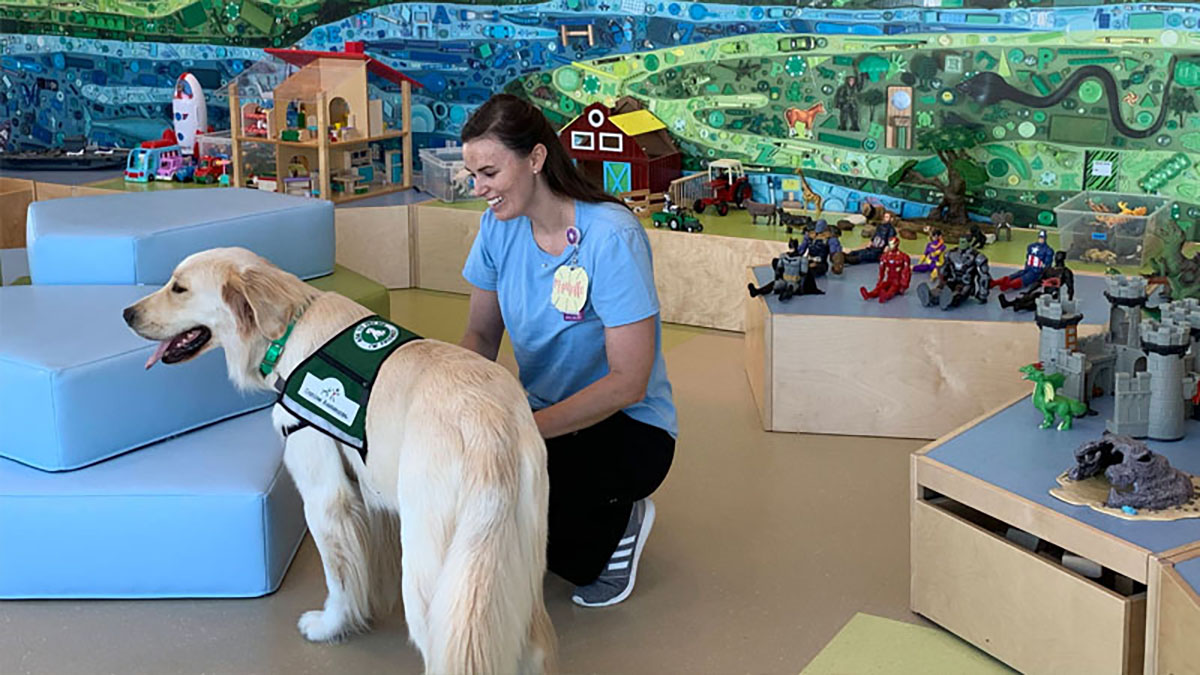“I said I’m not getting out of bed. I’m not walking your dog either,” the young patient said. “I’ve already walked a dog.”
His reluctance to leave his bed was understandable. No child wants to be in the hospital – and certainly not on Thanksgiving.
“But have you ever walked a turkey?” a child life specialist asked.
The patient brightened as a gentle golden retriever stepped into the room dressed as a Thanksgiving bird; the youngster’s reaction was to get out of bed and walk alongside his new furry and feathered friend.
Welcome to MUSC Shawn Jenkins Children’s Hospital, where Paws4TheKids has sparked breakthroughs like this one for the last two years.
Three years ago, Carolyn Donohue, former executive director of Nursing, Children’s, Women’s and Mental Health, identified the need for facility dogs in the MUSC SJCH family.
“At the time, I’d read various articles about facility dogs. We’re members of the Children’s Hospital Association, and there was a discussion within that network, too,” Donohue said.
The work involved in obtaining a facility dog can be daunting, but Donohue forged ahead, writing a grant to the Dunkin’ Joy in Childhood Foundation.
Donohue’s vision was a good match for the Foundation, whose mission is to provide joy and comfort for children battling hunger or illness. It awarded the grant and delivered the necessary funding.
“Getting the grant was only the beginning,” Donohue said. “The next step was getting the dogs.”
Few organizations train facility dogs, and it can take up to five years to receive one once a request is submitted. The Dunkin’ Joy Foundation works closely with Canine Assistants, a nonprofit in Milton, Georgia, that provided the Children’s Hospital’s first two facility dogs: golden retrievers Baskin and Agnes.
A dog such as Baskin, who donned the turkey costume, starts work in the morning and begins his journey through a myriad of tasks. He might jump on a bed and ride down to the operating unit with a child to decrease anxiety and be on hand when the patient wakes. He might participate in relationship building exercises with patients and staff. And he may help a child create a “pawsitive” memory of the hospital stay – a paint-stamped paw print mingled with the patient’s handprint on a canvas.
Donohue recently shared news about her “semi-retirement” and shift of the leadership reins for the program into the hands of Michelle Jeffcoat, child life specialist and facility dog program coordinator.
Jeffcoat and Amy Hauser, administrator for Children’s and Women’s services, share responsibility for the care of Baskin. Jeffcoat is Baskin’s “work mom,” and Hauser is his “home mom.”
“Child Life Services is all about communication through emotions and feelings through play – an outlet for the child’s anxiety. It’s fun and messy,” explained Betsy McMillan, manager of Child Life Services. “We are geared toward play to help them forget they are in the hospital. The facility dogs do an excellent job of that.”
McMillan recounted one child’s chemotherapy experience.
“Ten minutes in,” McMillan said, “she would get so anxious, so sick, they would have to stop the treatment and try again another day.”
When Agnes was brought in, the child was able to stay calm enough to make it past the first 10 minutes. The second time Agnes came in, she and the patient were lying together on a stretcher as the IV dripped.
“Right at the 10-minute mark, Agnes turned around, laid her head on the child’s lap and reached out her paw. It was amazing,” said McMillan. “It was like she was able to pick up on the exact moment the child’s anxiety began. I used to try not to read too much into things like this, but the dog’s intuition was undeniable. She knew when she was needed. A total empath.”
Visits, which can be anywhere from a few minutes to an hour, are timed depending upon need. The dogs get lunch breaks and bathroom breaks, just like everyone else.
“The only difference between a facility dog’s workday and everyone else’s is the number of snacks they receive,” Jeffcoat joked.
It’s not only the children who benefit from the presence of these happy creatures. Sometimes, Jeffcoat calls on Baskin to help with staff support.
“In our line of work, especially in pediatric ICU, things can get stressful for staff,” Jeffcoat explained. “Witnessing their interactions affirm the value of these dogs’ presence. Simple statements like that speak so large.”
Though she’s in “semi-retirement,” Donohue still has her eyes on the future of the program.
“The goal that gets tossed around is 10 working facility dogs,” she said. “Realistically, due to the demand, we’ll probably be able to get four to five more dogs over the next couple of years.”
They are also evaluating using facility dogs in the Child and Adolescent Unit of MUSC’s Institute of Psychiatry.
“There’s a possibility to expand,” Donohue stated. “We are learning more all the time and the program evolves with it.”
“I’m looking forward to the program’s growth,” said Jeffcoat. “As a matter of fact, we have a new dog coming on board.”
In mid-November, a golden retriever, Cher, a littermate to Sonny, joined the dog family that assists children in the Cancer and Blood Disorders Unit.
Any patient – young or young at heart – can request a visit from a Paws4TheKids staff member.
By Amy Gesell








